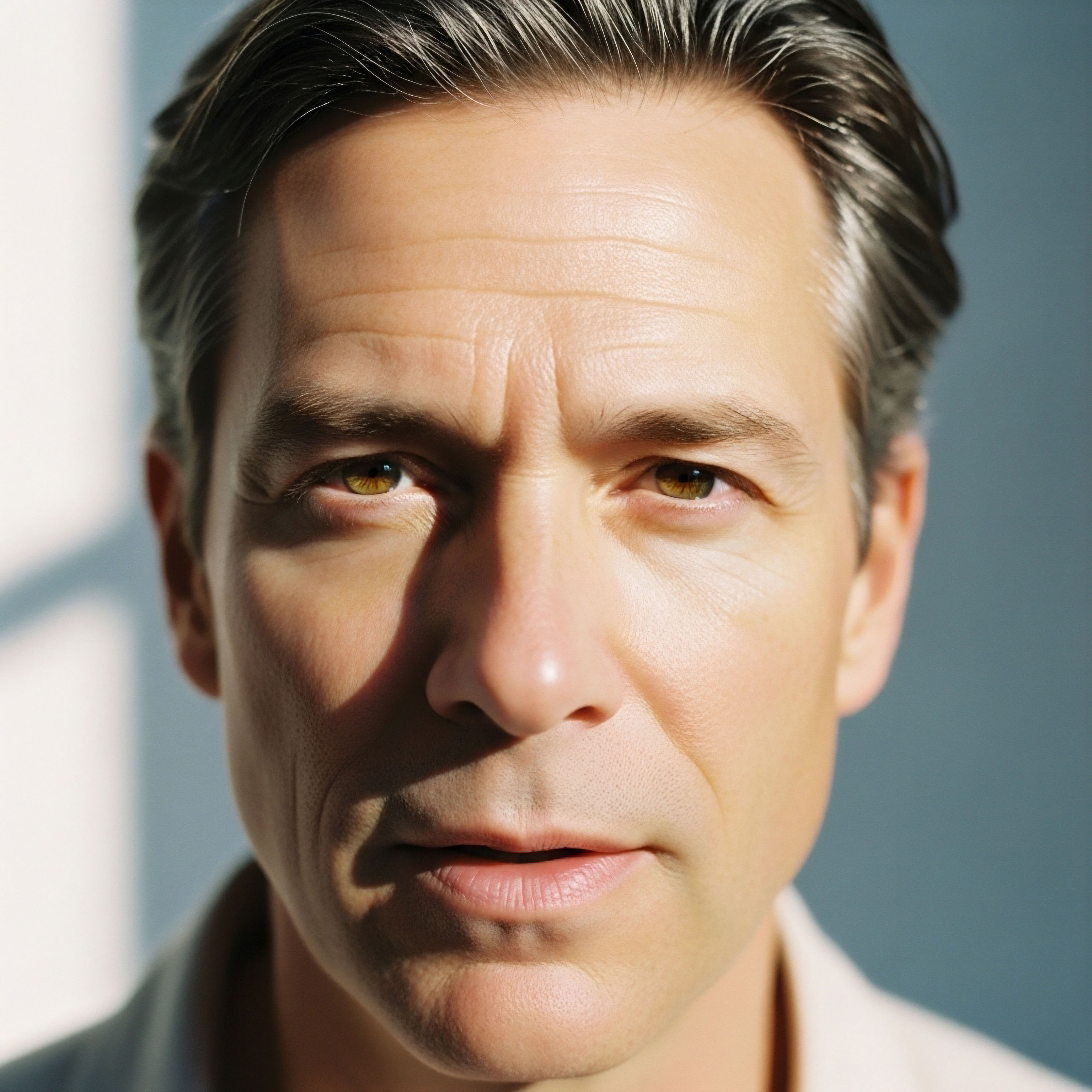

Fundamentals
A deep sense of uncertainty can settle when contemplating changes to one’s hormonal landscape, particularly when considering the cessation of testosterone replacement therapy. Many individuals embarking on a journey with exogenous testosterone do so to reclaim vitality, energy, and a sense of well-being, often experiencing a profound improvement in their daily lives.
The prospect of discontinuing such a beneficial protocol naturally brings questions about what lies ahead, especially concerning the body’s ability to restore its own delicate internal messaging systems. This concern about future family planning or simply the return of natural function is entirely valid, reflecting a deep connection to one’s biological capacity.
Understanding the body’s inherent mechanisms provides clarity. The endocrine system operates as a sophisticated network, with various glands communicating through chemical messengers known as hormones. These messengers regulate nearly every bodily process, from metabolism and mood to reproductive function. When external hormones are introduced, as in the case of testosterone replacement therapy, the body’s internal production often adjusts in response. This adjustment is a natural feedback loop, a finely tuned system designed to maintain balance.
Discontinuing testosterone therapy prompts the body to attempt a restoration of its inherent hormonal equilibrium.

The Hypothalamic Pituitary Gonadal Axis
Central to male hormonal health and fertility is the Hypothalamic-Pituitary-Gonadal (HPG) axis. This intricate communication pathway involves three primary components:
- Hypothalamus ∞ Located in the brain, it releases Gonadotropin-Releasing Hormone (GnRH). This hormone acts as the initial signal, instructing the pituitary gland.
- Pituitary Gland ∞ Situated at the base of the brain, it responds to GnRH by secreting two crucial hormones ∞ Luteinizing Hormone (LH) and Follicle-Stimulating Hormone (FSH). These are the direct messengers to the testes.
- Gonads (Testes) ∞ In men, the testes receive signals from LH and FSH. LH stimulates the Leydig cells within the testes to produce testosterone, the primary male sex hormone. FSH, on the other hand, stimulates the Sertoli cells, which are vital for supporting sperm production, a process known as spermatogenesis.
This axis functions like a precise thermostat. When testosterone levels are adequate, the hypothalamus and pituitary receive signals to reduce their output of GnRH, LH, and FSH, thereby moderating testosterone production. Conversely, when testosterone levels dip, the axis increases its signaling to stimulate more production.

Testosterone Therapy and Its Impact
Introducing exogenous testosterone, such as through injections, alters this natural feedback system. The body perceives sufficient testosterone circulating and, in response, reduces its own production of GnRH, LH, and FSH. This suppression leads to a decrease in the testes’ natural ability to produce testosterone and, critically, to generate sperm. For many individuals on testosterone replacement, this suppression of spermatogenesis means a temporary reduction or cessation of fertility.
The duration and dosage of testosterone therapy can influence the degree of suppression. Longer periods of therapy or higher doses may lead to more pronounced suppression of the HPG axis. However, the body possesses a remarkable capacity for recovery, though the timeline and completeness of this recovery can vary significantly among individuals. Understanding this fundamental interplay between external hormones and internal regulatory systems sets the stage for exploring the specific considerations involved in discontinuing therapy.


Intermediate
Discontinuing testosterone replacement therapy, particularly when fertility is a consideration, requires a thoughtful and strategic approach. The aim is to gently reawaken the body’s inherent capacity for hormone production and spermatogenesis, which may have been dormant during exogenous testosterone administration. This process involves specific clinical protocols designed to stimulate the HPG axis, guiding it back to its natural rhythm.

Reactivating the Endocrine System
The body’s internal communication system, when suppressed by external testosterone, needs precise signals to resume its operations. Medications used in post-TRT protocols act as these signals, targeting different points along the HPG axis to encourage the testes to restart their functions. This is not a simple flip of a switch; rather, it is a recalibration that requires patience and careful monitoring.
Post-TRT protocols employ targeted medications to stimulate the body’s natural testosterone and sperm production pathways.
The primary goal of these protocols is to elevate endogenous LH and FSH levels, which directly stimulate testicular function. Without adequate LH, the Leydig cells cannot produce sufficient testosterone. Without sufficient FSH, the Sertoli cells cannot effectively support sperm development.

Key Therapeutic Agents
Several medications are commonly employed in a post-TRT or fertility-stimulating protocol for men. Each agent operates through a distinct mechanism to support the restoration of the HPG axis:
- Gonadorelin ∞ This synthetic version of Gonadotropin-Releasing Hormone directly stimulates the pituitary gland to release LH and FSH. Administered via subcutaneous injections, often twice weekly, Gonadorelin provides a direct signal to the pituitary, mimicking the hypothalamus’s natural pulsatile release of GnRH. This direct stimulation helps to overcome the pituitary’s suppressed state, encouraging it to resume its role in the HPG axis.
- Tamoxifen ∞ A Selective Estrogen Receptor Modulator (SERM), Tamoxifen works by blocking estrogen receptors in the hypothalamus and pituitary. Estrogen, while vital, provides negative feedback to these glands, signaling them to reduce LH and FSH production when its levels are high. By blocking this feedback, Tamoxifen effectively “tricks” the hypothalamus and pituitary into believing estrogen levels are low, prompting them to increase GnRH, LH, and FSH secretion. This surge in gonadotropins then stimulates the testes.
- Clomiphene Citrate (Clomid) ∞ Similar to Tamoxifen, Clomid is also a SERM. It operates by competitively binding to estrogen receptors in the hypothalamus, preventing estrogen from exerting its negative feedback. This action leads to an increase in GnRH pulsatility, which in turn elevates LH and FSH levels. Clomid is frequently used to stimulate testicular function and spermatogenesis in men with secondary hypogonadism, making it a valuable tool in post-TRT recovery.
- Anastrozole ∞ An aromatase inhibitor, Anastrozole reduces the conversion of testosterone into estrogen in the body. While estrogen is necessary, excessively high levels can contribute to HPG axis suppression and other side effects. By lowering estrogen, Anastrozole can indirectly support the recovery of the HPG axis, particularly if estrogen dominance is a contributing factor to persistent suppression. It is often used judiciously and based on individual lab markers.
These medications are often used in combination, creating a synergistic effect to optimize the chances of restoring natural hormonal balance and fertility. The specific combination and dosages are highly individualized, determined by the patient’s unique physiological response, the duration and dosage of prior testosterone therapy, and their fertility goals.

Comparing Therapeutic Actions
Understanding the distinct actions of these agents helps to appreciate the precision of post-TRT protocols.
| Medication | Primary Mechanism of Action | Target in HPG Axis |
|---|---|---|
| Gonadorelin | Directly stimulates pituitary LH/FSH release | Pituitary Gland |
| Tamoxifen | Blocks estrogen negative feedback on hypothalamus/pituitary | Hypothalamus, Pituitary |
| Clomiphene Citrate | Blocks estrogen negative feedback on hypothalamus | Hypothalamus |
| Anastrozole | Reduces testosterone-to-estrogen conversion | Peripheral Tissues (indirect HPG support) |
The duration of these protocols varies, typically spanning several months, with regular monitoring of hormone levels (testosterone, LH, FSH, estrogen) and sperm parameters. This careful oversight ensures the protocol is adjusted as needed, guiding the body toward optimal function.


Academic
The long-term effects of testosterone replacement therapy cessation on male fertility represent a complex interplay of endocrine feedback loops, cellular responsiveness, and individual physiological variability. While the HPG axis possesses a remarkable capacity for recovery, the kinetics and completeness of this restoration are subjects of ongoing clinical investigation. A deep understanding of the underlying endocrinology and cellular biology provides a framework for appreciating the challenges and successes associated with post-TRT fertility protocols.

Mechanisms of HPG Axis Suppression and Recovery
Exogenous testosterone administration exerts its suppressive effect primarily through negative feedback on the hypothalamus and pituitary gland. Supra-physiological or even physiological levels of circulating testosterone, when administered externally, signal to the hypothalamus to reduce GnRH pulsatility. This diminished GnRH secretion, in turn, leads to a significant reduction in LH and FSH release from the anterior pituitary.
The Leydig cells in the testes, deprived of adequate LH stimulation, reduce endogenous testosterone synthesis, leading to testicular atrophy. Concurrently, the Sertoli cells, dependent on FSH and high intratesticular testosterone concentrations (maintained by LH-stimulated Leydig cells), cease their support of spermatogenesis. This results in azoospermia (absence of sperm) or severe oligozoospermia (very low sperm count) in a significant proportion of men on TRT.
Recovery of male fertility post-TRT cessation depends on the HPG axis regaining its intricate signaling capabilities.
Upon cessation of exogenous testosterone, the negative feedback is removed. The HPG axis then attempts to re-establish its normal pulsatile activity. The hypothalamus begins to secrete GnRH, stimulating the pituitary to release LH and FSH. The Leydig cells, once again stimulated by LH, resume testosterone production.
Simultaneously, FSH and the rising intratesticular testosterone levels encourage the Sertoli cells to restart spermatogenesis. This recovery process is not instantaneous. The spermatogenic cycle itself takes approximately 72-74 days, meaning that even with immediate HPG axis recovery, a significant delay exists before mature sperm can be observed in the ejaculate.

Factors Influencing Recovery Kinetics
Several variables can influence the speed and completeness of fertility recovery following TRT cessation. These factors underscore the individualized nature of hormonal responses:
- Duration of TRT ∞ Longer periods of exogenous testosterone administration are generally associated with a more prolonged recovery period for the HPG axis and spermatogenesis. While complete recovery is still possible, the time required may be extended.
- Dosage of TRT ∞ Higher doses of testosterone may lead to more profound and persistent suppression of the HPG axis, potentially requiring more aggressive or prolonged post-TRT stimulation protocols.
- Age of the Individual ∞ Younger men typically exhibit a more robust and rapid recovery of testicular function compared to older men, reflecting the natural decline in reproductive capacity with advancing age.
- Pre-existing Testicular Function ∞ Men with pre-existing conditions affecting testicular health or baseline hypogonadism may experience a more challenging recovery.
- Individual Genetic Predisposition ∞ Genetic variations can influence the sensitivity of the hypothalamus, pituitary, and testes to hormonal signals, affecting recovery trajectories.

Clinical Efficacy of Post-TRT Protocols
The protocols involving Gonadorelin, SERMs (Tamoxifen, Clomiphene), and aromatase inhibitors (Anastrozole) are designed to accelerate and optimize this recovery. Gonadorelin directly provides the pulsatile GnRH signal, bypassing a potentially sluggish hypothalamus. SERMs counteract the negative feedback of endogenous estrogen, thereby increasing LH and FSH. Aromatase inhibitors reduce estrogen levels, which can be beneficial if high estrogen is contributing to HPG axis suppression or causing undesirable side effects.
Clinical studies have demonstrated varying success rates for these protocols in restoring spermatogenesis. While many men achieve sperm counts sufficient for natural conception or assisted reproductive technologies, a subset may experience persistent oligozoospermia or azoospermia. The success of these interventions is often measured by the return of sperm to the ejaculate and the achievement of pregnancy.
| Intervention Strategy | Primary Mechanism | Expected Outcome for Fertility |
|---|---|---|
| TRT Cessation Alone | Removal of negative feedback | Gradual HPG axis recovery, variable spermatogenesis return |
| Gonadorelin Therapy | Direct pituitary stimulation | Accelerated LH/FSH release, improved testicular function |
| SERM Therapy (Clomid/Tamoxifen) | Estrogen receptor blockade in HPG axis | Increased endogenous LH/FSH, stimulated spermatogenesis |
| Aromatase Inhibitor (Anastrozole) | Reduced estrogen conversion | Indirect HPG support, reduced estrogenic side effects |
The decision to discontinue TRT for fertility purposes should always be made in consultation with a healthcare professional specializing in endocrinology or reproductive medicine. Comprehensive baseline assessments, including semen analysis and hormonal panels, are crucial before initiating TRT, and meticulous monitoring is required throughout the recovery phase. While the body’s capacity for self-regulation is profound, targeted clinical support can significantly enhance the prospects of restoring reproductive function.

References
- Bhasin, Shalender, et al. “Testosterone Therapy in Men With Hypogonadism ∞ An Endocrine Society Clinical Practice Guideline.” Journal of Clinical Endocrinology & Metabolism, vol. 103, no. 5, 2018, pp. 1715-1744.
- Khera, Mohit, et al. “A Systematic Review of the Effects of Testosterone Replacement Therapy on Fertility in Men.” Translational Andrology and Urology, vol. 6, no. 5, 2017, pp. 913-922.
- Shabsigh, Ridwan, et al. “Gonadotropin-Releasing Hormone Agonists and Antagonists in Male Infertility.” Fertility and Sterility, vol. 86, no. 5, 2006, pp. 1293-1300.
- Ramasamy, Ranjith, et al. “Testosterone Replacement Therapy and Male Infertility ∞ A Systematic Review.” Fertility and Sterility, vol. 102, no. 5, 2014, pp. 1289-1295.
- Swerdloff, Ronald S. and Christina Wang. “The Hypothalamic-Pituitary-Gonadal Axis in Men ∞ Physiology and Pathophysiology.” Endocrinology and Metabolism Clinics of North America, vol. 37, no. 1, 2008, pp. 1-17.
- Boron, Walter F. and Emile L. Boulpaep. Medical Physiology ∞ A Cellular and Molecular Approach. 3rd ed. Elsevier, 2017.
- Guyton, Arthur C. and John E. Hall. Textbook of Medical Physiology. 13th ed. Elsevier, 2016.
- Paduch, Darius A. et al. “Testosterone Replacement Therapy and Fertility ∞ A Systematic Review.” Current Opinion in Urology, vol. 24, no. 6, 2014, pp. 600-607.

Reflection
Considering the intricate dance of hormones within your body invites a deeper appreciation for its inherent intelligence. The journey of understanding your own biological systems, particularly after engaging with external support like testosterone therapy, is a testament to your commitment to well-being. This knowledge is not merely information; it is a lens through which you can view your own health with greater clarity and agency.
The path to hormonal balance and restored function is highly personal, reflecting the unique symphony of your internal physiology. Armed with a deeper understanding of the HPG axis and the targeted clinical tools available, you are better equipped to engage in meaningful conversations with your healthcare team.
This proactive stance, grounded in informed self-awareness, is the true pathway to reclaiming vitality and functioning at your optimal capacity. Your body possesses an incredible ability to adapt and respond, and by aligning with its natural rhythms, you can guide it toward its most vibrant expression.



